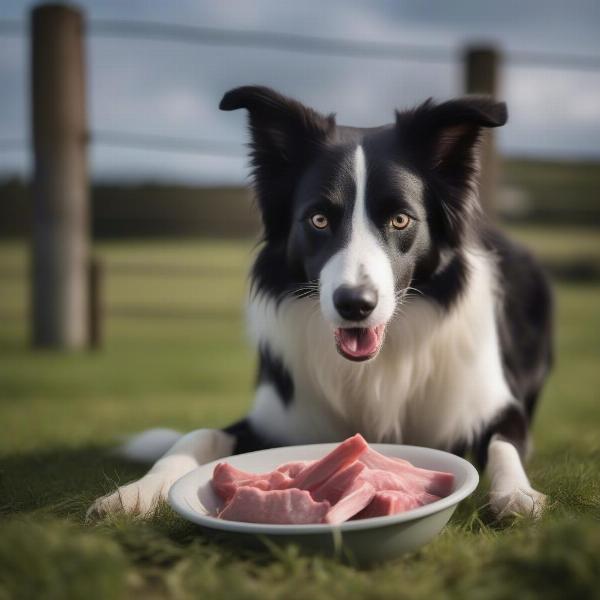Raw feeding for farm dogs has gained traction among owners seeking a natural and potentially beneficial diet for their hardworking companions. This comprehensive guide dives into the nuances of a “farm dog raw” diet, addressing key considerations, potential benefits, and risks, to help you determine if this feeding approach is right for your canine helper.
Understanding the “Farm Dog Raw” Diet
What exactly does “farm dog raw” entail? It refers to feeding a diet consisting primarily of uncooked meat, bones, organs, and sometimes fruits and vegetables, mirroring the ancestral diet of canines. Proponents argue this diet promotes better digestion, shinier coats, increased energy levels, and improved dental health. However, it’s crucial to understand the commitment and knowledge required to implement a raw diet safely and effectively.
 A farm dog enjoying a raw meat meal
A farm dog enjoying a raw meat meal
Benefits and Risks of a Raw Diet for Farm Dogs
A properly balanced raw diet can offer several potential advantages. Raw food often contains higher levels of natural nutrients and enzymes that can be lost during cooking. Chewing raw bones can contribute to dental hygiene, and some owners observe improved coat condition and increased energy in their dogs.
However, there are also inherent risks associated with raw feeding. Bacterial contamination is a significant concern, posing a threat to both the dog and the humans handling the raw food. Nutritional imbalances can occur if the diet isn’t carefully formulated, leading to deficiencies or excesses of certain nutrients. Furthermore, bones can splinter and cause internal injuries, especially if not properly selected and prepared.
Essential Nutrients for a Balanced “Farm Dog Raw” Diet
A balanced raw diet should include muscle meat, organ meat (including liver, kidney, and heart), bones (for calcium and phosphorus), and sometimes a small amount of fruits and vegetables. The precise ratio of these components will vary based on the dog’s age, size, activity level, and overall health.
Safe Handling and Preparation of Raw Dog Food
Strict hygiene practices are crucial when preparing raw dog food. Wash your hands thoroughly before and after handling raw meat. Use separate cutting boards, knives, and utensils for raw food and human food. Store raw meat in the refrigerator and thaw it safely in the refrigerator or under cold running water. Never thaw raw meat at room temperature.
Transitioning Your Farm Dog to a Raw Diet
Transitioning to a raw diet should be gradual to avoid digestive upset. Start by introducing small amounts of raw food alongside your dog’s current diet, gradually increasing the proportion of raw food over several days or weeks. Monitor your dog closely for any signs of digestive issues, such as vomiting or diarrhea.
Is “Farm Dog Raw” Right for Your Canine Companion?
Deciding whether to feed your farm dog a raw diet requires careful consideration. Consult with your veterinarian to assess the potential benefits and risks based on your dog’s individual needs and circumstances. They can help you formulate a balanced diet and provide guidance on safe handling and preparation practices.
Conclusion
A “farm dog raw” diet can offer potential benefits, but it also comes with inherent risks. Thorough research, careful planning, and meticulous hygiene practices are essential for safe and successful raw feeding. Always consult your veterinarian before making any significant dietary changes for your farm dog.
FAQs
-
What are the most common bacterial risks associated with raw feeding? Salmonella and E. coli are the primary bacterial concerns.
-
Can I feed my farm dog cooked bones? No, cooked bones can splinter and pose a serious choking hazard.
-
What are some signs of nutritional deficiencies in dogs on a raw diet? Signs can include weight loss, poor coat condition, lethargy, and digestive problems.
-
How often should I feed my farm dog a raw diet? Most adult dogs thrive on one to two meals per day.
-
Is a raw diet suitable for puppies and senior dogs? Puppies and senior dogs have specific nutritional needs, and a raw diet should be carefully formulated to meet those requirements. Consult with your veterinarian for personalized guidance.
-
Where can I get reliable information about raw feeding for dogs? Veterinary nutritionists and reputable online resources specializing in canine nutrition can provide valuable information.
-
What are some alternatives to a fully raw diet? Commercially available raw food diets that are pre-made and balanced can be a safer option than preparing raw food at home.
You Might Also Like
About ILM Dog
ILM Dog (https://ilmdog.com) is your trusted international resource for expert advice on dog care and nutrition. We cover a wide range of topics, from breed selection and training to health, nutrition, and grooming, catering to both new and experienced dog owners worldwide. Our expertise in dog nutrition encompasses various dietary approaches, including raw feeding. Whether you’re seeking guidance on switching to a raw diet or have questions about your dog’s overall health and wellbeing, ILM Dog is here to help. Contact us at [email protected] or +44 20-3965-8624.